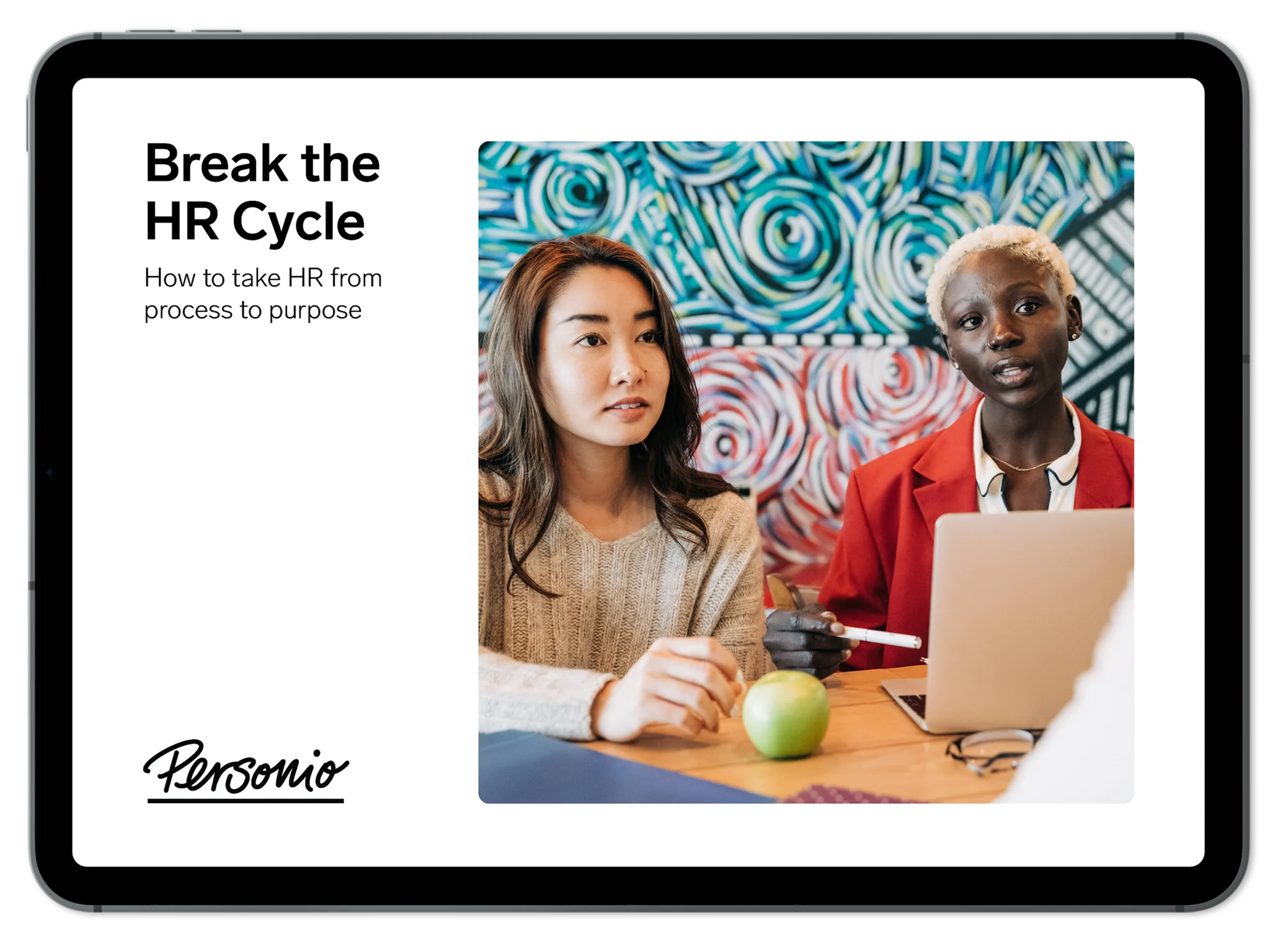
Are you stuck in an endless loop of time-consuming tasks?
Learn how to take HR from process to purpose.
Download NowWhat is the Harvard Model of HRM?

The Harvard HRM model is one of many great HR theories and models. When implemented correctly, it can help form the bedrock of effective HR management policy and procedure.
In this article, we explain what it is, discuss its essential elements, discuss the model’s strengths and weaknesses and answer some common questions…
Book a demo to see why 12,000+ companies trust Personio with their HR work.What Is the Harvard HRM Model?
The Harvard HRM model is considered one of the most influential ‘soft HRM’ approaches due to its focus on people rather than outcomes. The Harvard HRM model seeks to provide an optimal context for people to do their best work.
The model itself dates back to 1984 and comes from the book Managing Human Assets by Michael Beer, Richard E. Walton and Bert A. Spector.
The Harvard HRM Model in Practice
Taking a look at the illustration below, the Harvard HRM model suggests it is HR’s responsibility to consider all stakeholders when preparing HRM policies and planning for a long-term future.
Then, it proposes that HRM must make policy choices by assessing stakeholder interests and situational factors. These choices result in HR outcomes which will have long-term consequences for employees, the business and society.

The model is subsequently divided into five different sections and includes feedback loops to show that every element of the model affects or interplays with other elements.
The five critical elements of the Harvard HRM model include:
1. Stakeholder Interest
The model proposes that multiple stakeholders’ values, input and perspectives must be considered before creating any policies. These stakeholders include management, employee groups, government, the community and even unions.
2. Situational Factors
Before making policy choices, both internal and external factors should be considered as they all influence how humans operate. The model suggests looking at the following situational factors: workforce characteristics, business strategy and conditions, management philosophy, labour market, unions, tasks, technology, law and societal values.
3. HRM Policies and Policy Choices
The diagram below shows the way HRM policy areas interconnect:

HR policies require both work systems and reward systems to function. In other words: HR policy determines the approach management will take to work, rewards, how HR functions and how employees are influenced.
Employees work effectively when these elements find balance.
4. HR Outcomes
One of the most interesting and possibly best-known aspects of the Harvard HRM Framework is the list of HR outcomes (the 4Cs): Commitment, Congruence, Competence and Cost-effectiveness.
Here’s an example of how the 4Cs work:
If you find the right balance of HR policies, employees commit to organisational goals (and overall organisational development).
When employees are well-suited to management styles and collaborate effectively, you achieve congruence.
A competent organisation can attract, retain and develop employee competencies.
Can you maintain costs while helping employees stay motivated and satisfied with their jobs? If the answer is yes, you will have cost-effectiveness.
5. Long-Term Consequences
In essence, if you use the Harvard HRM model to prepare and execute HRM strategy, the belief is that there will be far-reaching, long-term consequences. The model argues that if an HRM strategy meets employees’ needs, this will help the organisation compete with the external market while benefiting society and the community.
Harvard Model of HRM: Strengths & Weaknesses
While the Harvard model of HRM has often been lauded as influential and important, no model is perfect. It does have its strengths and weaknesses, as we explain below.
Notable Strengths
The Harvard HRM model has been commended because it helps HR leaders and strategists see HRM in a broader context. By considering the balance between employees, operations and management, the model offers a robust framework to underpin effective HR work.
Other notable strengths of the Harvard model include:
Acknowledging that employees are active, rather than passive, agents and play a vital role in the organisation’s success or failure.
Helping attempt to balance multiple stakeholders’ needs. For example, the model’s creators emphasise the need for trade-offs but also remind us that, to be effective, HR strategy cannot be considered in isolation.
Reminding us that any HR strategy contains many moving parts while balancing the input of many interested parties.
Encouraging line managers to take more responsibility for employees rather than delegating to HR.
Helping HR leaders identify what is within or beyond their control. In addition, separating internal and external factors to set strategic HR within a real-world context.
Identifying the impact that seemingly unrelated decisions and actions can play on HR policies and the entire business.
Notable Weaknesses
The Harvard HRM model’s strength (its all-encompassing breadth of scope) can be overwhelming and hard to translate into reality. The authors focused on how to create an ideal model – not how to execute it. This is its biggest weakness.
This model also assumes that if HR meets all stakeholders’ interests, this will result in long-term utopian working practices that meet individuals’, society’s and the organisation’s long-term goals.
Unfortunately, while this is a noble and logical goal, the reality is often far different.
Frequently-Asked Questions About the Harvard Model of HRM
Here are a few frequently asked questions about the Harvard HRM model that you might find interesting…
What Are the Four Models of HRM?
The Harvard model is one of four key models of HRM. The four HRM models are the Fombrun, Harvard, Guest and Warwick models. Often studied by HR students, these models provide a helpful framework for HR planning. Using them gives credibility and legitimacy to HR policies.
Is the Harvard Model Considered Soft HRM?
Yes. The difference between ‘hard’ views of HR management and ‘soft’ views is that hard views focus more on results, objectives and KPIs – i.e. deliverables. Soft models focus more on people, attitudes, culture and motivation. The Harvard model takes a soft view of HR but is not entirely soft since it also considers the importance of reward systems, including payment.
Who Developed the Harvard Model of HRM?
Michael Beer is commonly acknowledged as the creator of the Harvard HRM Model. However, it was first published in 1984 by a group of experts at Harvard University, led by him. The other authors of Managing Human Assets are Bert Spector, Paul R. Lawrence, D. Quinn Mills and Richard E. Walton.
Putting The Harvard HRM Model Into Practice
Any HR model can give organisations and HR leaders a helpful start when creating HR policies or managing HR processes more effectively. But, sometimes, taking the time to research and apply models simply isn’t possible.
For everything from recruitment to HR management and even preliminary payroll, we can help. Book a demo to see how Personio could work for you today.
